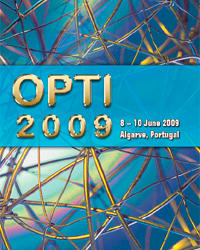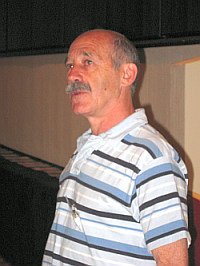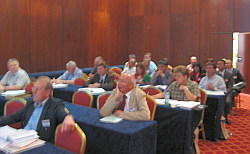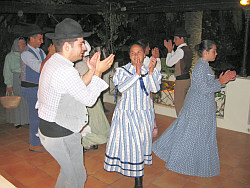Eleventh International Conference on Optimum Design of Structures and Materials in Engineering
Algarve, Portugal
Overview
 The 11th International Conference on Computer Aided Optimum Design of Structures and Materials in Engineering was recently held in the Algarve, Portugal, organised by the Wessex Institute of Technology (WIT), UK and the University of La Coruña, Spain.
The 11th International Conference on Computer Aided Optimum Design of Structures and Materials in Engineering was recently held in the Algarve, Portugal, organised by the Wessex Institute of Technology (WIT), UK and the University of La Coruña, Spain.The main objective of the meeting was to provide a friendly and useful forum for the interchange of ideas and initiatives among researchers, designers, and scholars of the optimisation community to share advances in design optimisation.
Nowadays it is widely accepted that optimisation techniques have much to offer to designers involved with new industrial products. The formulation of optimum design has evolved from the time it was an academic topic, unable to satisfy the requirements of real life prototypes. Since then, the development of new algorithms, the improvement of others, the appearance of powerful commercial computer codes with easy-to-use graphical interfaces and the revolution in speed of digital computers, created a fertile field for the incorporation of optimisation in the design process in several engineering disciplines. Although not all industrial sectors are using optimisation techniques daily, they are steadily being applied in more design cases.
Opening Address
The conference was organised by Professor Santiago Hernandez from the University of La Coruña and Professor Carlos Brebbia, Director of WIT, who referred to the work carried out at the Ashurst Lodge Campus in the New Forest. He also mentioned the importance of the conference programme for WIT, as one of the objectives of the Institute is the transfer of knowledge.Professor Brebbia explained that this transfer has evolved over the years as the range of projects studied at WIT involve many different disciplines, now even those involving humanities. This is a welcome development, Professor Brebbia believes, as it is essential to be able to communicate across different disciplines in order to solve the serious problems facing society today.
Professor Brebbia then proceeded to introduce his Co-Chairman, Professor Santiago Hernandez, who has collaborated with WIT for a long time. Professor Hernandez is a member of the Board of Directors of WIT and, in addition to this conference, has been actively involved with many of the Institute’s activities.
 Professor Hernandez opened the conference with a keynote address discussing the case of optimization of large problems with reference to aerospace applications. He started by discussing the formulation of optimisation problems which depends on the type of objective function under consideration.
Professor Hernandez opened the conference with a keynote address discussing the case of optimization of large problems with reference to aerospace applications. He started by discussing the formulation of optimisation problems which depends on the type of objective function under consideration.Optimisation has progressed considerably since 1960 when Schmit presented his paper on a three bar problem. In 2009, many optimisation problems routinely require the use of large computer capabilities. The case of the Messina Strait Bridge, analysed by Professor Hernandez’s group, for instance, requires working with many degrees of freedom to find an optimal solution for the deck. Any savings in such a project has of course important economic consequences. Reducing the thickness of the deck by 1mm, for instance, represents a saving of €6 million.
Another application of optimization by Professor Hernandez’s group has been for the tail section of the new A350 aircraft. This problem has 50,000 design variables.
Professor Hernandez reviewed the different ways in which large optimisation problems can be formulated, such as deterministic or reliability based optimisation.
The aim of his group’s work is to produce highly optimised design, a good understanding of the behaviour of aircraft structures, impact on the design material, and experience of performance of computer clusters. All of these are important conditions for the evolution of optimisation techniques since the pioneering work of Schmit in the 1960s.
Conference Sessions
The conference included papers dealing with algorithms while others described innovative design optimisation formulations applied in several engineering fields, including practical applications in industrial problems. The papers were grouped under the following topics:
The papers were grouped under the following topics:- New and enhanced algorithms
- Shape optimisation
- Topology optimisation
- Design optimisation in materials, construction and bridge engineering
- Design optimisation in aircraft engineering
- Design optimisation in dam and soil engineering
Invited Papers
The wide list of themes demonstrates the maturity of optimization methodologies and their vast number of possible applications. A series of invited lectures helped to illustrate some of the latest developments:- “Application of self-organizing maps to genetic algorithms” by E. Kita, Nagoya University, Japan
- “Mixed-integer non-linear programming approach to structural optimization” by S. Kravanja, University of Maribor, Slovenia
- “Cable optimization of a long span cable stayed bridge in La Coruña (Spain)” by S. Hernandez, University of La Coruña, Spain
- “External surfaces affected by free hydrogen in metastable austenitic stainless steels” by Y. Katz, Negba University, Israel
- “Optimum aerofoil parameterization for aerodynamic design” by R. Derksen, University of Minnetoba, Canada.
Panel Discussion
A special panel was set up at the end of the second day to discuss the future of optimisation. This gave rise to a lively discussion and exchange of ideas between the more senior participants and youngest members of the audience. The general conclusion was that the future of optimisation lies in extending its range of applications and in a closer integration of the methods within the design process.
There was ample opportunity for the participants to meet during the conference. The first night they were invited to a drinks party and throughout the meeting they were offered complimentary lunches.
International Scientific Advisory Committee
The International Scientific Advisory Committee met over dinner to discuss how the conference can be improved when it is reconvened in 2011. They discussed broadening the scope of the conference and a series of new topics were suggested, as well as new members of the International Scientific Advisory Committee. It was decided that the next meeting would be held in the Americas, the date and location to be decided shortly.
Conference Banquet
 The conference banquet took place in a restaurant renowned for its Portuguese cuisine. There the participants were able to taste a series of local delicacies, washed down by Duoro wines. Following that, a local folkloric group performed Algarve dances. The folklore of this region of Portugal is different from the rest of the country and is characterised by its fast pace and general feeling of joy and happiness. At the end of the performance, some of the participants demonstrated their energy and hidden talent by joining the dancers. At the end of the banquet, Professor Brebbia thanked the participants and gave them a gift as a reminder of the conference. This consisted of a piece of hand-made and hand-decorated pottery. The pieces are made as in the ancient past and the colours are those typical of pottery in this part of Europe, with a predominance of blue, green and yellow. The pottery was set up many years ago by a graduate from the Lisbon School of Arts, who wanted to produce pieces based on ancient traditions. Unfortunately, numbers of authentic ceramic workshops continue to decrease in the south of Europe, emphasising the importance of supporting remaining ones so as to retain these ancient skills.
The conference banquet took place in a restaurant renowned for its Portuguese cuisine. There the participants were able to taste a series of local delicacies, washed down by Duoro wines. Following that, a local folkloric group performed Algarve dances. The folklore of this region of Portugal is different from the rest of the country and is characterised by its fast pace and general feeling of joy and happiness. At the end of the performance, some of the participants demonstrated their energy and hidden talent by joining the dancers. At the end of the banquet, Professor Brebbia thanked the participants and gave them a gift as a reminder of the conference. This consisted of a piece of hand-made and hand-decorated pottery. The pieces are made as in the ancient past and the colours are those typical of pottery in this part of Europe, with a predominance of blue, green and yellow. The pottery was set up many years ago by a graduate from the Lisbon School of Arts, who wanted to produce pieces based on ancient traditions. Unfortunately, numbers of authentic ceramic workshops continue to decrease in the south of Europe, emphasising the importance of supporting remaining ones so as to retain these ancient skills.
Publication of Papers
 The proceedings of Computer Aided Optimum Design in Engineering XI, 288 pp (Print ISBN: 1-84564-185-6; Online ISBN: 1-84564-362-1; Print ISSN: 1746-4498) are available from WIT Press priced at £109/US$196/€138. Orders can be placed by telephone: +44 (0) 238 029 3223, fax: +44 (0) 238 029 2853, e-mail:
The proceedings of Computer Aided Optimum Design in Engineering XI, 288 pp (Print ISBN: 1-84564-185-6; Online ISBN: 1-84564-362-1; Print ISSN: 1746-4498) are available from WIT Press priced at £109/US$196/€138. Orders can be placed by telephone: +44 (0) 238 029 3223, fax: +44 (0) 238 029 2853, e-mail: Papers from the conference will also be hosted online at the WIT eLibrary as Volume 106 of WIT Transactions on The Built Environment (Online ISSN: 1743-1743-3509). For more details visit the WIT eLibrary at http://library.witpress.com.


 Wessex Institute
Wessex Institute